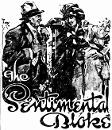AustLit
 8446372745420830197.jpg
8446372745420830197.jpg
Illustrated header from the advertisement in The Brisbane Courier, 20 December 1919, p.2 (via Trove Australia)
Adaptation of
The Songs of a Sentimental Bloke
1915
selected work
poetry
Issue Details:
First known date:
1919...
1919
The Sentimental Bloke
The material on this page is available to AustLit subscribers. If you are a subscriber or are from a subscribing organisation, please log in to gain full access. To explore options for subscribing to this unique teaching, research, and publishing resource for Australian culture and storytelling, please contact us or find out more.
Film Details - Southern Cross Feature Film Company , 1919 - ScreenSound Australia ; Australian Film Council , 2004
Producers:
Raymond Longford
Production Companies:
Southern Cross Feature Film Company
Director of Photography:
Arthur Higgins
Editors:
Lottie Lyell
Cast:
Incl. Arthur Tauchert (Bill 'The Bloke'), Lottie Lyell (Doreen), Gilbert Emery (Ginger Mick), Stanley Robinson (Bill's friend), Harry Young (Stror 'at Coot ), Margaret Reid (Mother), Charles Keegan (Parson), William Coulter (Uncle Jim), Helen Furgus (Nurse), C. J. Dennis (himself).
Release Dates:
4 October 1919 (Melbourne Town Hall - premiere). Released in Sydney on 18 October 1919.
The Sentimental Bloke was distribution in Australia and overseas by E. J. Carroll and Dan Carroll. Following its enormous commercial success, they decided to enter production themselves.
The film was released commercially as part of a two-disc box set by the National Film and Sound Archive in 2009 (distributed by Madman).
Location:
- Sydney, New South Wales (incl. Woolloomooloo)
Notes:
1. Assistant Directors: Arthur Cross and Clyde Marsh
2. Longford changed the location of the original story from Melbourne to Sydney, shooting street scenes in Woolloomooloo.
3. The National Film and Sound Archive's 2009 DVD release includes musical accompaniment by Jen Anderson and The Larrikins, an interview with the composer, and curatorial commentary, along with a scholarly book on the film and a flipbook demonstrating how consecutive images create moving pictures.
4. Little is yet known about the music that originally accompanied The Sentimental Bloke - particularly during the years 1919 and 1920. A few references to this aspect of the film's exhibition certainly indicate that the muscical accompaniment included songs - both instrumental and vocal. Several 'On and Off' and 'Screenery' columns in Smith's Weekly (1920), for example, contain brief pars relating to the issue of songs. In the 6 March issue a contributor records the complaint of an audience member (Stevo Stubbs) which relates to the pianist having mostly played refrains from English coster songs like 'Knocked 'Em in the Old Kent Road,' Mrs 'Enery 'Awkins' and 'E Dunno Where 'e Are' instead of using local material (p. 20). Earlier in the year the same newspaper also published references to the use of Bert Royle and Teddy Lonnen's 'Australianised' coster song, 'Ive Chucked Up the Push for the Donah,' during the New Zealand screenings (17 and 31 Jan, p. 20).
5. In her interview for the 2009 DVD box set, composer Jen Anderson, indicates that she did not use jazz music as her frame of reference for the reconstructed version's soundtrack, preferring folk music instead, because jazz had not become popular in Australia by 1919. This is historically inaccurate on three counts. Firstly, the closely-related music form, ragtime (which Anderson does not refer to) had been a staple of the variety theatre stage from the early years of the twentieth century. By 1904 US ragtime songs were being included in songsters produced by Australian publishers - Albert and Sons American Annual series, for example. Within ten years rag songs were being incorporated into every aspect of the Australia popular stage, including pantomimes, and numerous local variety composers/performers were having their own songs published - including for example, Tommy Armstrong, Vince Courtney and Nat Phillips (aka Stiffy, of Stiffy and Mo fame). Ragtime's popularity began to decline by the late 1910s/early 1920s in response to jazz (namely dixieland). The second issue, relates to the introduction and almost immediate success of jazz in Australia. After being introduced to variety audiences in 1918, advertisements quickly began appearing in newspapers and trade magazines around the country promoting not only the music, but also dancing (including lessons). The speed at which jazz arrived in this country via the international variety circuit is noted by Andrew Bissett who writes: 'Sydney may have heard [New Orleans] jazz before Chicago' (p. 1). The third issue relating to the music of the era is the lack of evidence supporting any claim that folk was the music of the popular (or working-class) culture. Extensive research conducted by Dr Clay Djubal into Australian variety theatre during the 1910s has so far failed to find any mention of folk music (or traditional bush ballads) being performed. This is because variety theatre was based on popular culture production - which is itself reliant on new or latest styles and fashions. Folk music, even in the 1910s and 1920s, therefore had no currency with the contemporary audience. [sources: Clay Djubal, 'What Oh Tonight,' pp. 250-261 ; and Andrew Bissett Black Roots, White Flowers, pp. 1-9]
Further Reference:
- 'Sentimental Bloke (1919).' Images. The National Film and Sound Archive - online (sighted 26/11/2010).
- 'Sentimental Bloke, The.' Rewind. ABC Television - online (sighted 26/11/2010).
- 'Sentimental Bloke, The.' Treasures of the National Library, National Library of Australia - online (sighted 26/11/2010).
- 'Sentimental Bloke, The.' Trove: Digitised Newspapers and More. National Library of Australia - online (sighted 26/11/2010).
Settings:
- Inner Sydney, Sydney, New South Wales,
- Urban,
- 1910s


